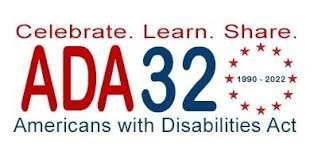Happy 32nd Anniversary to the Americans with Disabilities Act

It certainly can be easy to take modern conveniences like public education and transportation, the communication network, or even the availability of different employment options for granted. In fact, I suspect most of us enjoy these benefits with little thought to the fact that until just 32 years ago it was legal to refuse access to many based upon their disability. The segment of the population considered disabled is not insignificant. In fact, according to the CDC, 61 million adults live with a disability: For reference, that is 26% of the total adult population or more than a quarter of our fellow citizens. In reality, the stigma surrounding disability doesn’t really seem to make sense with over a quarter of the population living with disability, which can really be considered a different baseline of ability.
Signed into law on July 26th, 1990, the Americans with Disabilities Act (ADA) represents an expansion of those whose rights are protected by 1964’s Civil Rights Act. While the Civil Rights Act of 1964 made discrimination based on race, religion, sex, national origin, and other characteristics illegal, the ADA extended the same protection to those living with disability. It would be erroneous to believe the stroke of George H.W. Bush’s pen on that late summer day in 1990 was simply the culmination of an effort began with the bills introduction to congress in 1988. As Arlene Mayerson chronicles in “The History of the Americans with Disabilities Act: A Movement Perspective” (1992) for the Disability Rights Education & Defense Fund (https://dredf.org/about-us/publications/the-history-of-the-ada/), the ADA truly represented the crescendo of a true societal push for change.
At the Senate’s first hearing pertaining to the ADA, two Senators and one Rep. gave personal and moving testimony. Senator Harkin spoke touchingly of the challenges faced by his hearing impaired brother while Senator Kennedy described the obstacles in his son’s, a leg amputee, path to engaging in society. Perhaps the most moving information came in the testimony of Representative Coelho whose impassioned telling of how the discrimination he faced nearly destroyed him. Undoubtably, the testimony of a congressional colleague resonated deeply with the Senators present. The thousands of letters and personal testimony corroborating the struggle faced by those in the disabled community created immense momentum for action.
The first-hand experience of a Vietnam veteran left paralyzed and using a wheelchair who found himself trapped in his housing project and unable to access public transportation because of inaccessibility was touching. When he told of the discrimination he felt in looking for employment leaving him to conclude “he had fought for everyone, but himself,” he added that he would fight valiantly for the ADA’s passage.
Ultimately, the ADA would pass the Senate with a large margin (76-8), to be considered by four committees in the House. While the bill seemed to stall, the incredible disability rights movement remained committed to the initiative. After finally reaching the House floor and receiving a passing vote, the ADA made its way to President Bush’s desk to be signed into law. After many years of struggle, those in the oft marginalized disabled community would receive equal opportunity and access not as charity, but a legislated right guaranteed by the ADA!